
Wine Culture and Information since 2002 - Volume 22
 Wine Culture and Information since 2002 - Volume 22 |
|
Issue 138, March 2015 |
Contents |
|
|
Luigi Veronelli: Walking the Land |
|
It took place at the “Triennale di Milano” - from January 21 to February 24, 2015 - an exhibition dedicated to the greatest of Italian journalists and wine writers, the one who started the revaluation in Italy of wine and olive oil: Luigi Veronelli. Moreover, he also had the undeniable merit of having started, in his personal, unattainable and inimitable style, the accounting of wine and food in Italy. The exhibition, with the significant title ”camminare la terra” (walking the land), has been realized thanks to the important contribution of Comitato Decennale Luigi Veronelli, founded to commemorate and celebrate the great “Gino” on the anniversary of the tenth year from his death. The committee also aims to spread the thought and work of Luigi Veronelli, with events started the last 2 February 2014. A certainly significant date, as the same day of 1926 the great “Gino” was born in Milan in the famous “Isola” district, among the most characteristic ones of the capital of Lombardy.
I have already written in DiWineTaste about my admiration for Luigi Veronelli: his books certainly are among the best ones I have in my personal library about food and wine, books I keep on reading all the time, always giving me the very same joy and pleasure. My age lets me remember - and with affection - about his TV shows in particular the renowned “a tavola alle sette”, broadcasted by Italian television and hosted with the great actress Ave Ninchi. With his kindness and good manners, something absolutely missing in today's television, Luigi Veronelli talked, with his personal style, about food and wine of Italy, with the simplicity of his huge smile, emphasized by his black framed glasses. At those times I was a boy, however that TV show, besides the subjects covered in each episode, was pretty funny also because of the provocative contrast - and evidently friendly - between Luigi Veronelli and Ave Ninchi. A lovely TV show, polite and joyous - with the reassuring Ave Ninchi's smile entering every house - of which I keep a dear and affectionate memory. A dream coming true about these memories was when I personally met Luigi Veronelli - it happened just once in my life - and I admit I was very excited for seeing him in front of me. He was at the booth of his publishing house in a very popular Italian wine exhibition, I was simply a passionate visitor: it was 1999 and DiWineTaste would have seen his birth few years later. My very first “conscious” meeting with wine certainly was because of Luigi Veronelli and his participation to TV shows, at least until they let him doing so. Impossible to forget, the TV show “Viaggio sentimentale nell'Italia dei vini” (sentimental journey to the Italy of wines) broadcast in 1979 by Italian Rai 3 channel, in which was given voice to that wine unknown to many. I therefore started collecting his books and writings about wine: my very first interesting and educational readings on this subject were all signed by the great “Gino”. I warmly welcomed the news about the exhibition “camminare la terra” and dedicated to Luigi Veronelli: an event for no reason at all I would have not failed to visit. A well set up room and in which was even reconstructed a very small part of Luigi Veronelli's personal cellar, following a path in which were displayed the most significant “battles” of the great Gino and his works. Pictures, reports of magazines and newspapers, books, letters, projects and even the showing of parts of the TV show “a tavola alle sette”, the exhibition has been nice to see and well made. Everything was, of course, about Luigi Veronelli's thought and work, with simple and significant items, in order to let visitors understand the soul and thought of the journalist, writer, defender of peasant culture and land. Battles he paid at a very high price: in two specific cases he was even sentenced to jail, including the silly penalty of the burning of one of his books, the very last penalty of this kind sentenced in Italy. Of particular interest, the reconstruction, at the center of the room, of a small part of Luigi Veronelli's personal cellar: the original one is so big that it needs a map in order to walk through the over 70.000 bottles. In the exhibition was displayed a very modest number of wines, however significant, with bottles ideally touching many Italian regions, including extraordinary French wines as well as from other parts of the world. At the entrance, there was a plate in which was written how that cellar was the primary job and study place for Luigi Veronelli, where he was continuously evaluating wines and the same bottles - year after year - in order to understand their evolution. I am sure the great Gino, in his personal winery, had not the problem of getting bored. Not because of the fact he could enjoy all those wines, but also for the pleasure of watching the bottles, ordered and well placed, just like the paintings of a cathedral. A wonderful experience in which I spend about five hours, enjoying books, reports, pictures and bottles, a time passed by with pleasure and no regrets. Surrounded by many memories, including the pleasure of admiring so many Luigi Veronelli's books while being pleased of the fact - with much pride and satisfaction - I too own a copy of those books. The exhibition “camminare la terra” will be moved from Milan to Bergamo, where it can be visited during the entire period of the forthcoming Expo 2015. The exhibition will in fact be set up in the monastery of Astino from 1 May to 31 October 2015, where - they say - it will also be reconstructed a miniature replica of the huge Luigi Veronelli's cellar. As far as I am concerned, I will certainly visit the exhibition in Bergamo too. An absolutely important event I suggest everyone visiting, a respectful tribute to the greatest Italian wine and food writer. There is no doubt without him and the path he traced for everyone, the world of wine, olive oil and food in Italy would not certainly be the same. Thank you Gino. Antonello Biancalana
|
||||||||||||
Contrasts of Fiano and RieslingTwo grapes expressing different and distant territories, one originates from the sunny lands of Campania, the other one in the more severe climate of Germany |
|
Two glorious grapes, expression of two distant territories in every sense, both capable of expressing white wines of indisputable magnificence. The first one of the two - Fiano - despite it is cultivated in some territories of South Italy only, has its best expression in Campania, in particular, in the territory of Avellino. The second one - Riesling - originates from Germany and it is the indisputable glory of Mosel wines, capable of giving masterpieces of remarkable class, elegance and finesse. The spreading of Riesling is such that, today, it is considered an international variety, even cultivated in territories not perfectly suited to this variety, its fame catches the attention and dreams of many producers. The spreading of Fiano is certainly more limited - it can be hardly found outside South Italy - however this is not an obstacle to its fame and greatness, undeniably one of the most important varieties of Italy. Before talking about Riesling, we should clear a confusion concerning another pretty common variety in Italy - in particular in the northern-eastern areas of Italy and Oltrepo Pavese - known as Riesling Italico. For the sake of clearness, it should be said the variety we will cover in this report is Rhine Riesling, having no connection with the “Italian” one, also known as Welschriesling. Not only the two varieties have nothing in common, even the wines they give are completely different and, in particular, quite different aging potentials over time. The confusion is however common and sometimes the two varieties are wrongly believed to be the same. For this reason, certain producers expressly write “Rhine Riesling” (Riesling Renano in Italian) in their labels in order to distinguish it from Welschriesling. It however must be said that, in general terms, the simple mention of “Riesling” refers to “Rhine Riesling”. Fiano is one of the many varieties existing since remote times in the Italian territory and introduced by ancient Greeks. The grape was successful since the very beginning of its introduction, catching the interest not just of men who made wine from it. Even insects, bees in particular (ape in Italian), were attracted by the sweetness of the juice of this variety and, for this reason, the grape was called vitis apicia. This name was later changed into Fiano, passing through apina, therefore apiana, then afiana and finally Fiano. To this variety was even dedicated the very first place in which vineyards of Fiano were historically planted in: Lapio, in province of Avellino, was in fact named after this ancient variety. Even today, Lapio has not lost its very ancient tradition and the cultivation of Fiano plays a fundamental role, as well as wine production, among the most significant lands of Fiano di Avellino. Found all over the territory of Campania, Fiano is also cultivated in Basilicata, Apulia, Molise and it is also found - although marginally - in other regions of Italy. The most important land of Fiano is however Campania, in particular the area of Avellino, the territory which has certainly received the highest success and attention. It should however be noticed, because of the huge diversity of the vast territory of Campania, from sandy soils of coastlines to volcanic soils, Fiano expresses wines with quite different characters, different one from each other, all however being of remarkable interest. The composition of soil, the availability of water and micro climate conditions of soil give in fact very different interpretations of Fiano. For example, we could consider the finesse and minerality of Fiano di Avellino compared to the more full and robust interpretations of Cilento, in province of Salerno.
Germany is the indisputable homeland of Riesling, besides being the land in which this variety originates from. Moreover, a good expression is also obtained in Alsace, despite the fact we should notice this variety is considered “international”, therefore found in many wine countries of the world. Riesling is also one of the few white varieties capable of making wines suited for a long aging in bottle. It is in fact not rare, given the proper wine making and keeping conditions, a wine produced with Riesling can give its best even after more than ten years from vintage, a quality not easy to have with most of white wines. On this regard, we can certainly say most of Riesling bottles are uncorked while in their youth, without giving them the chance to a magnificent evolution. For the sake of truth, it should be said not all the Riesling is made with this goal in mind. One of the most known characteristics of aged Riesling is the typical smell of petrol and kerosene. This particular quality of Riesling is very appreciated by many wine lovers, whereas it can also be considered unpleasing by many occasional drinkers. Grape of remarkable versatility, Riesling gives extraordinary dry table wines, as well as “late harvest” and sweet wines by using dried grapes. Riesling is also appreciated in the production of the so called eiswein, wines of extraordinary balance thanks to its characteristic acidity, nevertheless, having an elegant olfactory and gustatory profile. Wines of strong crispness, even in their youth are however capable of giving pleasing emotions, mainly of fruits and flowers, according to the territory and, in any case, of strong personality. Fiano and Riesling are capable of making wines with remarkable potentials of aging, while giving back, after some years, nectars of extraordinary greatness, although keeping their respective personalities. In our tasting we will compare two wines produced with Fiano and Riesling in their “young” condition, in order to emphasize differences. The study of mature wines produced with these two varieties certainly is amazing, however not suited for the goal of our tasting, as we are mainly interested in focusing on differences of the two grapes in their young condition and not altered by time. On this regard, we will therefore pick two wines of the same vintage and young, that is having no more than two years of aging in bottle. It would be better to get a Riesling from German Mosel, however produced in a cool climate area. As for Fiano, we will pick a bottle produced in the territory of Avellino.
Let's start the tasting of the two wines from appearance analysis, a phase universally accepted by the many sensorial evaluation methods as the primary analysis in a wine. Differences will be evident by a simple observation of the two glasses, something which will emphasize the diversities in color nuances. Both wines have a high transparency - a typical characteristic in most of the whites - and this is the only common quality in the two wines. The color of Fiano shows, in general terms, a darker hue than Riesling. The famous Italian grape can in fact show a straw yellow color, even very intense, with nuances of greenish yellow, whereas Riesling is characterized by a greenish yellow color. In the German grape will be in fact observed a paler color with evident greenish nuances, hues which can be observed even in Fiano, although with a lesser impact. The olfactory profiles of Fiano and Riesling are very interesting and, despite both varieties benefit from the evolution of time, even in their young wines is possible to perceive pleasing and complex aromas. Different olfactory profiles, they however represent excellent wines and suited for the study of sensorial tasting. The differences of the two varieties are evident, in particular, during the evaluation of the opening - that is the aromas perceived at the first smell and without swirling the glass - however offering common qualities. The olfactory realm of Fiano and Riesling is mainly represented by aromas belonging to the family of fruit, nevertheless, it will also be found aromas of flowers. Finally, it should be noticed the vinification of these two varieties is mainly made in inert containers, a technique allowing the best aromatic expression of Fiano and Riesling. By holding the glass in vertical position and without swirling, let's proceed with the comparison of olfactory profiles of the two wines, starting from Fiano. The opening of the great white grape of Campania, gives to the nose pleasing and intense aromas of apple, pear, peach and plum, as well as perceptions of hazelnut, this one very typical in wines produced with Fiano grape. To complete the profile will follow flower aromas of hawthorn and broom. The opening of Riesling, evaluated by holding the glass still and without swirling, is characterized by an olfactory profile quite different from Fiano. From the glass will be mainly perceived aromas recalling citrus fruits, in particular lemon and cedar, to which are added pleasing aromas of apricot, peach and apple. Aromas recalling flowers will mainly express broom and jasmine. Finally, a characteristic pretty common in Riesling is an elegant mineral “touch”, a quality which can also be found in Fiano. Let's proceed with the evaluation of the differences of the two wines by means of gustatory analysis. At the taste, the attack of Fiano - that is the first sensation perceived at the very first sip of the wine - is characterized by a pleasing crispness. It will also be perceived the role of alcohol, that in wines produced with this variety reaches an appreciable quantity: its burning effect will tend to balance the pleasing acidity. Fiano has a good body that, it should be noticed, gets even fuller in case the grape is cultivated in clay soils. The attack of Riesling too allows the appreciation of an evident crispness - more accentuated than Fiano - also caused by the fact in these wines, in particular those made in Germany, the quantity of alcohol is lower. This characteristic therefore favors the exaltation of acidity. The structure of Riesling generally is weaker than Fiano, in particular in those wines produced in cool climate areas, such as Germany. The final phase of our contrast tasting will try to focus on the differences of the two wines after having swallowed them. Fiano, a white grape of well known quality, generally makes wines with a persistent finish and in which can be mainly perceived flavors of apple, plum and peach, most of the times can also be perceived its typical sensation of hazelnut. The finish of Riesling, also in this case, a variety of indisputable quality, is persistent as well and in the mouth are generally perceived flavors recalling citrus fruits, in particular, lemon. In this wine can also be perceived flavors of peach, apricot and tropical fruits, as well as a pleasing sensation of acidity. Two great grapes, expression of distant lands, capable of making extraordinary wines, with a remarkable elegance and class, qualities requiring, in any case, the talent of man and his land.
|
||||||||||||||||||||
Wines of the Month |
|
|
|
Score legend Prices are to be considered as indicative. Prices may vary according to the country or the shop where wines are bought |
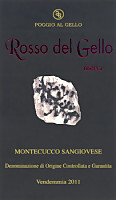
|
|
Montecucco Sangiovese Riserva Rosso del Gello 2011 |
|
| Poggio al Gello (Tuscany, Italy) | |
 Sangiovese Sangiovese | |
| Price: € 18.00 | Score: |
 Brilliant ruby red and nuances of garnet red, moderate transparency. Brilliant ruby red and nuances of garnet red, moderate transparency. Intense, clean, pleasing and refined, starts with hints of plum, black
cherry and dried violet followed by aromas of blueberry, blackberry,
tobacco, vanilla, carob and menthol. Intense, clean, pleasing and refined, starts with hints of plum, black
cherry and dried violet followed by aromas of blueberry, blackberry,
tobacco, vanilla, carob and menthol.
 Properly tannic attack and however balanced by alcohol, good body,
intense flavors, agreeable. Properly tannic attack and however balanced by alcohol, good body,
intense flavors, agreeable.
 Persistent finish with flavors of black cherry, plum and blueberry. Persistent finish with flavors of black cherry, plum and blueberry. 24 months in cask, 6 months in bottle. 24 months in cask, 6 months in bottle. |
|
 Broiled meat, Stewed meat with mushrooms, Stuffed pasta Broiled meat, Stewed meat with mushrooms, Stuffed pasta |
|
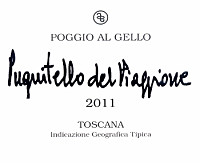
|
|
Pugnitello del Piaggione 2011 |
|
| Poggio al Gello (Tuscany, Italy) | |
 Pugnitello Pugnitello | |
| Price: € 22.00 | Score: |
 Intense ruby red and nuances of ruby red, little transparency. Intense ruby red and nuances of ruby red, little transparency. Intense, clean, pleasing and refined, start with hints of black cherry,
plum and blackberry followed by aromas of violet, black currant, blueberry,
vanilla, chocolate and black pepper. Intense, clean, pleasing and refined, start with hints of black cherry,
plum and blackberry followed by aromas of violet, black currant, blueberry,
vanilla, chocolate and black pepper.
 Tannic attack and however balanced by alcohol, full body, intense
flavors, agreeable. Tannic attack and however balanced by alcohol, full body, intense
flavors, agreeable.
 Persistent finish with flavors of black cherry, blackberry and black
currant. Persistent finish with flavors of black cherry, blackberry and black
currant.
 12 months in barrique, 6 months in bottle. 12 months in barrique, 6 months in bottle. |
|
 Game, Roasted meat, Braised and stewed meat, Hard cheese Game, Roasted meat, Braised and stewed meat, Hard cheese |
|
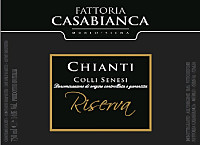
|
|
Chianti Colli Senesi Riserva 2011 |
|
| Fattoria Casabianca (Tuscany, Italy) | |
 Sangiovese (85%), Merlot (5%), Canaiolo (5%), Colorino (5%) Sangiovese (85%), Merlot (5%), Canaiolo (5%), Colorino (5%) | |
| Price: € 9.50 | Score: |
 Intense ruby red and nuances of garnet red, moderate transparent. Intense ruby red and nuances of garnet red, moderate transparent. Intense, clean, pleasing and refined, starts with hints of black
cherry, plum and violet followed by aromas of blueberry, blackberry,
vanilla, chocolate, mace, tobacco and menthol. Intense, clean, pleasing and refined, starts with hints of black
cherry, plum and violet followed by aromas of blueberry, blackberry,
vanilla, chocolate, mace, tobacco and menthol.
 Properly tannic attack and however balanced by alcohol, good body
intense flavors, agreeable. Properly tannic attack and however balanced by alcohol, good body
intense flavors, agreeable.
 Persistent finish with flavors of black cherry, plum and blueberry. Persistent finish with flavors of black cherry, plum and blueberry. 6 months in barrique, 5 months in bottle. 6 months in barrique, 5 months in bottle. |
|
 Broiled meat and barbecue, Roasted meat, Stewed meat with mushrooms Broiled meat and barbecue, Roasted meat, Stewed meat with mushrooms |
|
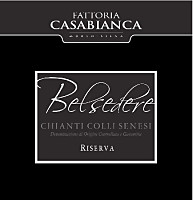
|
|
Chianti Colli Senesi Riserva Belsedere 2008 |
|
| Fattoria Casabianca (Piedmont, Italy) | |
 Sangiovese Sangiovese | |
| Price: € 22.50 | Score: |
 Brilliant ruby red and nuances garnet red, moderate transparency. Brilliant ruby red and nuances garnet red, moderate transparency. Intense, clean, pleasing and refined, starts with hints of black
cherry, plum and violet followed by aromas of blueberry, blackberry,
tobacco, vanilla, chocolate, mace and menthol. Intense, clean, pleasing and refined, starts with hints of black
cherry, plum and violet followed by aromas of blueberry, blackberry,
tobacco, vanilla, chocolate, mace and menthol.
 Properly tannic attack and however balanced by alcohol, good body,
intense flavors, pleasing crispness. Properly tannic attack and however balanced by alcohol, good body,
intense flavors, pleasing crispness.
 Persistent finish with flavors of black cherry, plum and blueberry. Persistent finish with flavors of black cherry, plum and blueberry. 18 months in barrique, 6 months in cask. 18 months in barrique, 6 months in cask. |
|
 Broiled meat and barbecue, Roasted meat, Stewed meat with mushrooms, Hard cheese Broiled meat and barbecue, Roasted meat, Stewed meat with mushrooms, Hard cheese |
|
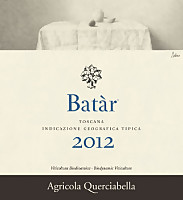
|
|
Batàr 2012 |
|
| Querciabella (Tuscany, Italy) | |
 Chardonnay (50%), Pinot Blanc (50%) Chardonnay (50%), Pinot Blanc (50%) | |
| Price: € 90.00 | Score: |
 Intense straw yellow and nuances of golden yellow, very transparent. Intense straw yellow and nuances of golden yellow, very transparent. Intense, clean, pleasing, refined and elegant, starts with hints of
banana, apple and plum followed by aromas of hawthorn, pear, pineapple,
butter, mango, grapefruit, acacia, vanilla, grapefruit, peach and praline. Intense, clean, pleasing, refined and elegant, starts with hints of
banana, apple and plum followed by aromas of hawthorn, pear, pineapple,
butter, mango, grapefruit, acacia, vanilla, grapefruit, peach and praline.
 Crisp attack and however balanced by alcohol, full body, intense
flavors, pleasing roundness. Crisp attack and however balanced by alcohol, full body, intense
flavors, pleasing roundness.
 Very persistent finish with long flavors of banana, plum and apple. Very persistent finish with long flavors of banana, plum and apple. 9 months in barrique, 6 months in bottle. 9 months in barrique, 6 months in bottle. |
|
 Roasted fish, Stuffed pasta with mushrooms, Roasted white meat, Stewed white meat Roasted fish, Stuffed pasta with mushrooms, Roasted white meat, Stewed white meat |
|
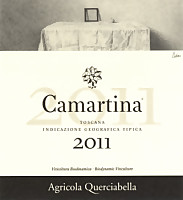
|
|
Camartina 2011 |
|
| Querciabella (Tuscany, Italy) | |
 Cabernet Sauvignon (70%), Sangiovese (30%) Cabernet Sauvignon (70%), Sangiovese (30%) | |
| Price: € 100.00 | Score: |
 Intense ruby red and nuances of ruby red, little transparency. Intense ruby red and nuances of ruby red, little transparency. Intense, clean, pleasing, refined and elegant, starts with hints of
black currant, black cherry and violet followed by aromas of plum,
blueberry, blackberry, vanilla, cocoa, tobacco, face powder, leather,
licorice and eucalyptus. Intense, clean, pleasing, refined and elegant, starts with hints of
black currant, black cherry and violet followed by aromas of plum,
blueberry, blackberry, vanilla, cocoa, tobacco, face powder, leather,
licorice and eucalyptus.
 Tannic attack and however balanced by alcohol, full body, intense
flavors, agreeable. Tannic attack and however balanced by alcohol, full body, intense
flavors, agreeable.
 Very persistent finish with long flavors of black currant, black cherry
and plum. Very persistent finish with long flavors of black currant, black cherry
and plum.
 18 months in barrique, 8 months in bottle. 18 months in barrique, 8 months in bottle. |
|
 Game, Stewed and braised meat, Roasted meat, Hard cheese Game, Stewed and braised meat, Roasted meat, Hard cheese |
|
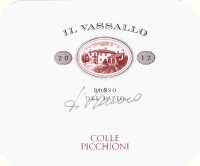
|
|
Il Vassallo 2012 |
|
| Colle Picchioni (Latium, Italy) | |
 Merlot (60%), Cabernet Sauvignon (30%), Cabernet Franc (10%) Merlot (60%), Cabernet Sauvignon (30%), Cabernet Franc (10%) | |
| Price: € 22.00 | Score: |
 Intense ruby red and nuances of ruby red, little transparency. Intense ruby red and nuances of ruby red, little transparency. Intense, clean, pleasing, refined and elegant, starts with hints of black
currant, black cherry and plum followed by aromas of violet, blueberry,
tobacco, vanilla, chocolate, iris, graphite and eucalyptus. Intense, clean, pleasing, refined and elegant, starts with hints of black
currant, black cherry and plum followed by aromas of violet, blueberry,
tobacco, vanilla, chocolate, iris, graphite and eucalyptus.
 Tannic attack and however balanced by alcohol, full body, intense
flavors, pleasing roundness. Tannic attack and however balanced by alcohol, full body, intense
flavors, pleasing roundness.
 Persistent finish with flavors of black currant, black cherry and plum. Persistent finish with flavors of black currant, black cherry and plum. 12 months in cask and barrique. 12 months in cask and barrique. |
|
 Game, Roasted meat, Stewed and braised meat, Hard cheese Game, Roasted meat, Stewed and braised meat, Hard cheese |
|

|
|
Trento Brut Perlé 2007 |
|
| Ferrari (Trentino, Italy) | |
 Chardonnay Chardonnay | |
| Price: € 32.00 | Score: |
 Brilliant straw yellow and nuances of greenish yellow, very
transparent, fine and persistent perlage. Brilliant straw yellow and nuances of greenish yellow, very
transparent, fine and persistent perlage.
 Intense, clean, pleasing, refined and elegant, starts with hints of
banana, apple and bread crust followed by aromas of acacia, yeast, citrus
fruits, plum, praline, grapefruit, peach and butter. Intense, clean, pleasing, refined and elegant, starts with hints of
banana, apple and bread crust followed by aromas of acacia, yeast, citrus
fruits, plum, praline, grapefruit, peach and butter.
 Effervescent and crisp attack, however balanced by alcohol, good body,
intense flavors, pleasing roundness. Effervescent and crisp attack, however balanced by alcohol, good body,
intense flavors, pleasing roundness.
 Persistent with flavors of apple, banana and grapefruit. Persistent with flavors of apple, banana and grapefruit. Refermented in bottle on its lees for 5 years. Refermented in bottle on its lees for 5 years. |
|
 Cold cuts, Pasta with fish, Roasted fish, Roasted white meat Cold cuts, Pasta with fish, Roasted fish, Roasted white meat |
|
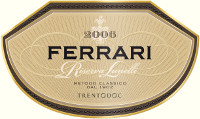
|
|
Trento Extra Brut Riserva Lunelli 2006 |
|
| Ferrari (Trentino, Italy) | |
 Chardonnay Chardonnay | |
| Price: € 44.00 | Score: |
 Brilliant golden yellow and nuances of golden yellow, very transparent,
fine and persistent perlage. Brilliant golden yellow and nuances of golden yellow, very transparent,
fine and persistent perlage.
 Intense, clean, pleasing, refined and elegant, starts with hints of
apple, bread crust and banana followed by aromas of pear, plum, pineapple,
praline, candied fruits, honey, hazelnut, vanilla, brioche, butter, yeast
and rosemary. Intense, clean, pleasing, refined and elegant, starts with hints of
apple, bread crust and banana followed by aromas of pear, plum, pineapple,
praline, candied fruits, honey, hazelnut, vanilla, brioche, butter, yeast
and rosemary.
 Effervescent and crisp attack, however balanced by alcohol, good body,
intense flavors, pleasing roundness. Effervescent and crisp attack, however balanced by alcohol, good body,
intense flavors, pleasing roundness.
 Very persistent finish with very long flavors of apple, plum and
banana. Very persistent finish with very long flavors of apple, plum and
banana.
 Aged in cask, refermented in bottle on its lees for 7 yesrs. Aged in cask, refermented in bottle on its lees for 7 yesrs. |
|
 Stuffed pasta, Roasted white meat, Roasted fish, Fish soups Stuffed pasta, Roasted white meat, Roasted fish, Fish soups |
|
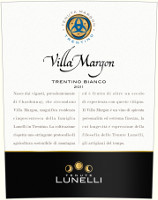
|
|
Trentino Bianco Villa Margon 2011 |
|
| Lunelli (Trentino, Italy) | |
 Chardonnay (80%), Pinot Blanc (10%), Sauvignon Blanc, Incrocio Manzoni (10%) Chardonnay (80%), Pinot Blanc (10%), Sauvignon Blanc, Incrocio Manzoni (10%) | |
| Price: € 15.00 | Score: |
 Intense straw yellow and nuances of straw yellow, very transparent. Intense straw yellow and nuances of straw yellow, very transparent. Intense, clean, pleasing and refined, starts with hints of apple,
banana and citrus fruits followed by aromas of plum, acacia, grapefruit,
hawthorn, pear, vanilla, hazelnut and mineral. Intense, clean, pleasing and refined, starts with hints of apple,
banana and citrus fruits followed by aromas of plum, acacia, grapefruit,
hawthorn, pear, vanilla, hazelnut and mineral.
 Crisp attack and however balanced by alcohol, good body, intense
flavors, pleasing roundness. Crisp attack and however balanced by alcohol, good body, intense
flavors, pleasing roundness.
 Persistent finish with flavors of apple, banana and plum. Persistent finish with flavors of apple, banana and plum. A part ages in cask. A part ages in cask. |
|
 Mushroom soups, Stuffed pasta, Roasted fish, Roasted white meat Mushroom soups, Stuffed pasta, Roasted fish, Roasted white meat |
|
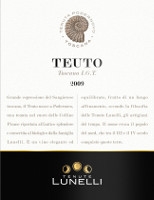
|
|
Teuto 2009 |
|
| Tenuta Podernovo (Tuscany, Italy) | |
 Sangiovese (95%), Merlot (5%) Sangiovese (95%), Merlot (5%) | |
| Price: € 18.00 | Score: |
 Brilliant ruby red and nuances of garnet red, moderate transparency. Brilliant ruby red and nuances of garnet red, moderate transparency. Intense, clean, pleasing and refined, starts with hints of black
cherry, plum and violet followed by aromas of blueberry, raspberry,
vanilla, chocolate, tobacco, cinnamon and menthol. Intense, clean, pleasing and refined, starts with hints of black
cherry, plum and violet followed by aromas of blueberry, raspberry,
vanilla, chocolate, tobacco, cinnamon and menthol.
 Tannic attack and however balanced by alcohol, good body, intense
flavors, pleasing crispness. Tannic attack and however balanced by alcohol, good body, intense
flavors, pleasing crispness.
 Persistent finish with flavors of black cherry, plum and raspberry. Persistent finish with flavors of black cherry, plum and raspberry. 24 months in cask, 12 months in bottle. 24 months in cask, 12 months in bottle. |
|
 Broiled meat and barbecue, Roasted meat, Stewed meat with mushrooms, Hard cheese Broiled meat and barbecue, Roasted meat, Stewed meat with mushrooms, Hard cheese |
|
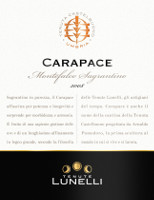
|
|
Montefalco Sagrantino Carapace 2008 |
|
| Tenuta Castelbuono (Umbria, Italy) | |
 Sagrantino Sagrantino | |
| Price: € 26.00 | Score: |
 Intense ruby red and nuances of garnet red, little transparency. Intense ruby red and nuances of garnet red, little transparency. Intense, clean, pleasing, refined and elegant, starts with hints of
blackberry, plum and black cherry followed by aromas of dried violet,
blueberry, vanilla, tobacco, dried rose, chocolate, mace, licorice and
menthol. Intense, clean, pleasing, refined and elegant, starts with hints of
blackberry, plum and black cherry followed by aromas of dried violet,
blueberry, vanilla, tobacco, dried rose, chocolate, mace, licorice and
menthol.
 Tannic attack and however balanced by alcohol, full body, intense
flavors, agreeable. Tannic attack and however balanced by alcohol, full body, intense
flavors, agreeable.
 Persistent finish with flavors of blackberry, black cherry and
blueberry. Persistent finish with flavors of blackberry, black cherry and
blueberry.
 24 months in cask, 12 months in bottle. 24 months in cask, 12 months in bottle. |
|
 Game, Roasted meat, Braised and stewed meat, Hard cheese Game, Roasted meat, Braised and stewed meat, Hard cheese |
|
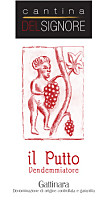
|
|
Gattinara Il Putto 2007 |
|
| Cantina Delsignore (Piedmont, Italy) | |
 Nebbiolo Nebbiolo | |
| Price: € 18.00 | Score: |
 Brilliant ruby red and nuances of brick red, moderate transparency. Brilliant ruby red and nuances of brick red, moderate transparency. Intense, clean, pleasing and refined, starts with hints of cherry, plum
and dried violet followed by aromas of raspberry, dried rose, vanilla,
chocolate, tobacco, cinnamon, licorice and menthol. Intense, clean, pleasing and refined, starts with hints of cherry, plum
and dried violet followed by aromas of raspberry, dried rose, vanilla,
chocolate, tobacco, cinnamon, licorice and menthol.
 Tannic attack and however balanced by alcohol, full body, intense
flavors, pleasing crispness. Tannic attack and however balanced by alcohol, full body, intense
flavors, pleasing crispness.
 Persistent finish with flavors of cherry, raspberry and plum. Persistent finish with flavors of cherry, raspberry and plum. 2 years in cask, 1 year in bottle. 2 years in cask, 1 year in bottle. |
|
 Game, Roasted meat, Stewed and braised meat, Hard cheese Game, Roasted meat, Stewed and braised meat, Hard cheese |
|
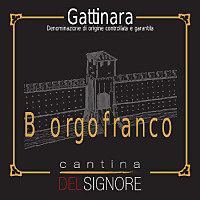
|
|
Gattinara Riserva Borgofranco 2006 |
|
| Cantina Delsignore (Piedmont, Italy) | |
 Nebbiolo Nebbiolo | |
| Price: € 22.00 | Score: |
 Brilliant ruby red and nuances of brick red, moderate transparency. Brilliant ruby red and nuances of brick red, moderate transparency. Intense, clean, pleasing and refined, starts with hints of plum, cherry
and dried violet followed by aromas of raspberry, blueberry, vanilla,
tobacco, cinnamon, licorice and menthol. Intense, clean, pleasing and refined, starts with hints of plum, cherry
and dried violet followed by aromas of raspberry, blueberry, vanilla,
tobacco, cinnamon, licorice and menthol.
 Properly tannic attack and however balanced by alcohol, full body,
intense flavors, pleasing crispness. Properly tannic attack and however balanced by alcohol, full body,
intense flavors, pleasing crispness.
 Persistent finish with flavors of plum, cherry and raspberry. Persistent finish with flavors of plum, cherry and raspberry. 3 years in cask, 1 year in bottle. 3 years in cask, 1 year in bottle. |
|
 Game, Roasted meat, Stewed and braised meat, Hard cheese Game, Roasted meat, Stewed and braised meat, Hard cheese |
|
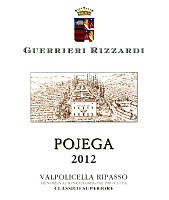
|
|
Valpolicella Classico Superiore Ripasso Pojega 2012 |
|
| Guerrieri Rizzardi (Veneto, Italy) | |
 Corvina (45%), Corvinone (45%), Rondinella, Molinara, Merlot (10%) Corvina (45%), Corvinone (45%), Rondinella, Molinara, Merlot (10%) | |
| Price: € 11.90 | Score: |
 Brilliant ruby red and nuances of garnet red, moderate transparency. Brilliant ruby red and nuances of garnet red, moderate transparency. Intense, clean, pleasing and refined, starts with hints of black
cherry, plum and blackberry followed by aromas of blueberry, dried violet,
vanilla, tobacco, chocolate and cinnamon. Intense, clean, pleasing and refined, starts with hints of black
cherry, plum and blackberry followed by aromas of blueberry, dried violet,
vanilla, tobacco, chocolate and cinnamon.
 Properly tannic attack and however balanced by alcohol, good body,
intense flavors, agreeable. Properly tannic attack and however balanced by alcohol, good body,
intense flavors, agreeable.
 Persistent finish with flavors of black cherry, plum and blackberry. Persistent finish with flavors of black cherry, plum and blackberry. 12 months in cask. 12 months in cask. |
|
 Broiled meat and barbecue, Stewed meat with mushrooms, Hard cheese Broiled meat and barbecue, Stewed meat with mushrooms, Hard cheese |
|
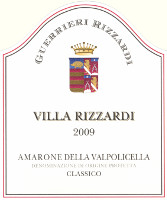
|
|
Amarone della Valpolicella Classico Villa Rizzardi 2009 |
|
| Guerrieri Rizzardi (Veneto, Italy) | |
 Corvinone (42%), Rondinella (30%), Corvina (18%), Barbera (10%) Corvinone (42%), Rondinella (30%), Corvina (18%), Barbera (10%) | |
| Price: € 38.50 | Score: |
 Intense ruby red and nuances of garnet red, little transparency. Intense ruby red and nuances of garnet red, little transparency. Intense, clean, pleasing and refined, starts with hints of plum,
blackberry and black cherry followed by aromas of dried violet, blueberry,
vanilla, mace, chocolate and menthol. Intense, clean, pleasing and refined, starts with hints of plum,
blackberry and black cherry followed by aromas of dried violet, blueberry,
vanilla, mace, chocolate and menthol.
 Tannic attack and however balanced by alcohol, full body, intense
flavors, pleasing roundness. Tannic attack and however balanced by alcohol, full body, intense
flavors, pleasing roundness.
 Persistent finish with flavors of plum, blackberry and black cherry. Persistent finish with flavors of plum, blackberry and black cherry. 12 months in barrique, 24 months in cask. 12 months in barrique, 24 months in cask. |
|
 Game, Roasted meat, Braised and stewed meat, Hard cheese Game, Roasted meat, Braised and stewed meat, Hard cheese |
|
News |
|
In this section are published news and information about events concerning the world of wine and food. Whoever is interested in publishing this kind of information can send us a mail to our address.
|
AquavitaeReview of Grappa, Distillates and Brandy |
|
|
| Distillates are rated according to DiWineTaste's evaluation method. Please see score legend in the "Wines of the Month" section. |
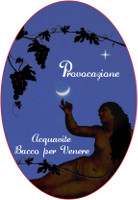
|
|
Acquavite Provocazione Bacco per Venere |
|
| Nannoni (Tuscany, Italy) | |
 Pomace of many grapes Pomace of many grapes | |
| Price: € 32.00 - 700ml | Score: |
 Pale golden yellow, limpid and crystalline. Pale golden yellow, limpid and crystalline. Intense, clean, pleasing, refined and elegant with aromas of honey,
hazelnut, prune, date, chocolate, vanilla, dried fig, with almost
imperceptible alcohol pungency. Intense, clean, pleasing, refined and elegant with aromas of honey,
hazelnut, prune, date, chocolate, vanilla, dried fig, with almost
imperceptible alcohol pungency.
 Intense flavors and perceptible alcohol pungency which tends to
dissolve rapidly, pleasing roundness and sweetness. Intense flavors and perceptible alcohol pungency which tends to
dissolve rapidly, pleasing roundness and sweetness.
 Persistent finish with flavors of prune, hazelnut and honey. Persistent finish with flavors of prune, hazelnut and honey. Distilled in a batch steam operated alembic still, Aged in barrique. Distilled in a batch steam operated alembic still, Aged in barrique.
|
|
Wine Parade |
|
|
| The best 15 wines according to DiWineTaste's readers. To express your best three wines send us an E-mail or fill in the form available at our WEB site. |
| Rank | Wine, Producer | |
|---|---|---|
| 1 |
| I Sodi di San Niccolò 2008, Castellare di Castellina |
| 2 |
| Adarmando 2011, Tabarrini |
| 3 |
| Sagrantino di Montefalco Collepiano 2007, Arnaldo Caprai |
| 4 |
| Montiano 2011, Falesco |
| 5 |
| Pelago 2009, Umani Ronchi |
| 6 |
| Brunello di Montalcino Montosoli 2009, Altesino |
| 7 |
| Villa Gresti 2006, Tenuta San Leonardo |
| 8 |
| Torgiano Rosso Riserva Rubesco Vigna Monticchio 2007, Lungarotti |
| 9 |
| Amarone della Valpolicella Classico Capitel Monte Olmi 2007, Tedeschi |
| 10 |
| Verdicchio dei Castelli di Jesi Classico Superiore Podium 2010, Garofoli |
| 11 |
| Collio Ribolla Gialla L'Adelchi 2012, Venica |
| 12 |
| Brunello di Montalcino Vigneto Manachiara 2007, Tenute Silvio Nardi |
| 13 |
| Offida Rosso Il Grifone 2008, Tenuta Cocci Grifoni |
| 14 |
| Brunello di Montalcino Vigna Loreto 2007, Mastrojanni |
| 15 |
| Maximo 2010, Umani Ronchi |
| |||||||
Privacy Policy | |||||||


| Copyright © 2002-2024 Antonello Biancalana, DiWineTaste - All rights reserved |
| All rights reserved under international copyright conventions. No part of this publication and of this WEB site may be
reproduced or utilized in any form or by any means, electronic or mechanical, without permission in writing from DiWineTaste. |